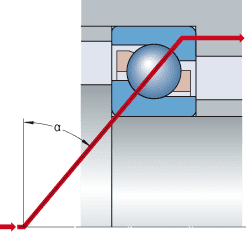Angular contact ball bearings
Angular contact ball bearings have inner and outer ring raceways that are displaced relative to each other in the direction of the bearing axis. This means that these bearings are designed to accommodate combined loads, i.e. simultaneously acting radial and axial loads.
The axial load carrying capacity of angular contact ball bearings increases as the contact angle increases. The contact angle is defined as the angle between the line joining the points of contact of the ball and the raceways in the radial plane, along which the combined load is transmitted from one raceway to another, and a line perpendicular to the bearing axis (fig. 1).
The most commonly used designs are:
single row angular contact ball bearings (fig. 2)
double row angular contact ball bearings (fig. 3)
four-point contact ball bearings (fig. 4)
In addition to the bearings presented in this section, other angular contact ball bearings include:
Super-precision angular contact ball bearings
Refer to Super-precision bearings.
Fixed section angular contact ball bearings
These bearings have very thin rings and a constant cross-sectional height within a particular series, irrespective of the bearing size. They are characterized by a low weight and high stiffness. SKF fixed section bearings have inch sizes and are available open or sealed in up to eight different cross-sectional heights. The designs include:
single row angular contact ball bearings (fig. 5)
four-point contact ball bearings (fig. 6)
Hub bearing units
Hub bearing units (HBU) for the automotive industry are based on double row angular contact ball bearings (fig. 7, fig. 8, fig. 9). They have made an appreciable contribution to the achievement of more compact weight-saving designs, simplified assembly and enhanced reliability.
Detailed information about these products and variants for industrial applications can be supplied on request.

